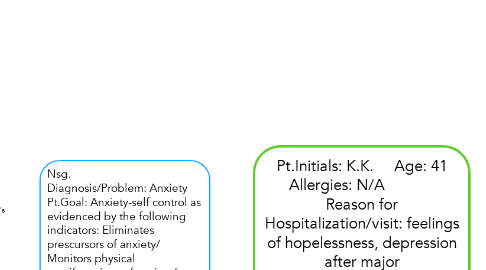Pt.Initials: K.K. Age: 41 Allergies: N/A Reason for Hospitalization/visit: feelings of hopelessness, depression after major loses. PMH: N/A Assessment Priorities:
by Marirose Watters

1. Nsg. Diagnosis/Problem: Anxiety Pt.Goal: Anxiety-self control as evidenced by the following indicators: Eliminates prescursors of anxiety/ Monitors physical manifestations of anxiety/ Controls anxiety response Supporting Subjective/Objective Data & Findings: decrease in productivity, poor eye contact, worry about change in life event, helplessness
1.1. Nsg. Interventions for Goal: Assess the client's level of anxiety and physical reactions to anxiety; use empathy to encourage the client to interpret the anxiety symptoms as normal; if irrational thoughts or fears are present, offer the client accurate info and encourage her to talk about the meaning of the events contributing to the anxiety; encourage the client to use positive self-talk
1.2. Evaluation of Goal: Rate the outcome and indicators of social involvement 1= never demonstrated, 2= rarely demonstrated, 3=sometimes demonstrated, 4=often demonstrated, 5=consistently demonstrated
2. Nsg. Diagnosis/Problem: Social Isolation Pt.Goal: Social Involvement as evidenced by the following indicator: Interacts with family, members of work groups Supporting Subjective/Objective Data & Findings: absence of support system, aloneness imposed by others, desire to be alone, feeling different from others, poor eye contact, withdrawn
2.1. Nsg. Interventions for Goal: establish a therapeutic relationship with the client; observe for barriers to social interaction; discuss/assess causes of perceived or actual isolation; allow client opportunities to describe her daily life and to introduce any issues that may be of concern; promote social interactions; assist the client in identifying specific health and social problems-involve her in their resolution
2.2. Evaluation of Goal: Rate the outcome and indicators of social involvement 1= never demonstrated, 2= rarely demonstrated, 3=sometimes demonstrated, 4=often demonstrated, 5=consistently demonstrated
3. Nsg. Diagnosis/Problem: Grieving Pt.Goal: Grief resolution as evidenced by the following indicators: Resolves feelings about the loss/Verbalizes reality and acceptance of loss/Maintains living environment/Seeks social Support Supporting Subjective/Objective Data & Findings: Loss of daughter to suicide, alteration in activity level, despair, psychological distress, suffering
3.1. Nsg. Interventions for Goal: Grief work facilitation; dying care; emotional support; hope instillation; support system enhancement; family support; family integrity promotion
3.2. Evaluation of Goal: Rate the outcome and indicators of social involvement 1= never demonstrated, 2= rarely demonstrated, 3=sometimes demonstrated, 4=often demonstrated, 5=consistently demonstrated
4. Nsg. Diagnosis/Problem: Hopelessness Pt.Goal: Presence of hope as evidenced by the following indicators: expresses expectation of a positive future/Expresses faith/ Expresses will to live Supporting Subjective/Objective Data & Findings: decrease in initiative, decrease in verbalization, poor eye contact
4.1. Nsg. Interventions for Goal: asses for, monitor and document the potential for suicide; assess for hopelessness with the modified Beck Hoplessness Scale; Engage the client in a therapeutic relationship to enhance social connectedness and social support networks; Determine appropriate approaches based on the underlying condition or situation that is contributing to feelings of hopeless; Encourage clients to discuss hope, because discussion may be helpful to increase hope; Assist clients in developing realistic goals for their recovery
4.2. Evaluation of Goal: Rate the outcome and indicators of social involvement 1= never demonstrated, 2= rarely demonstrated, 3=sometimes demonstrated, 4=often demonstrated, 5=consistently demonstrated



